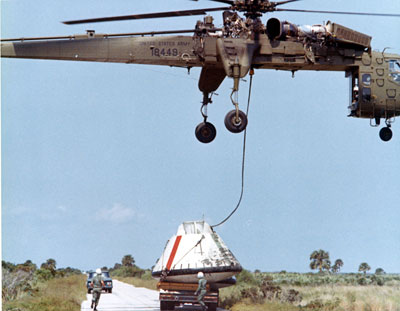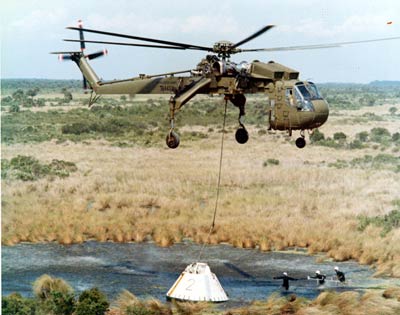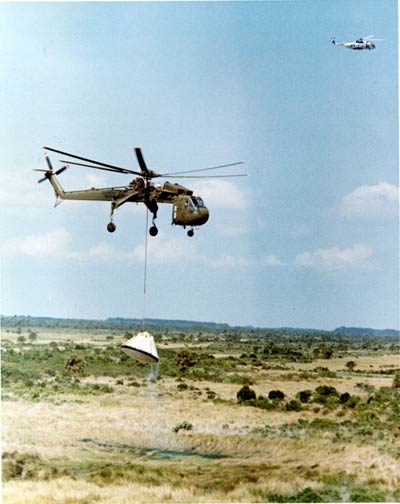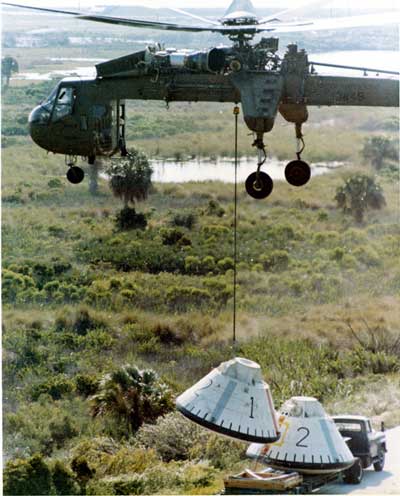Gumdrops and dragonfliesby Dwayne A. Day
|
 |
In one photograph some flight crewmen can be seen running out to one of the boilerplates carrying what appears to be a ladder. The boilerplate is resting in one of the many spring-fed ponds common to the area. They were probably going out to unhook the cable so that the helicopter could retreat. Visible in the distance is a USAF HH-3 “Jolly Green Giant” rescue helicopter of the Aerospace Rescue and Recovery Service (ARRS).
Although there are no details or captions accompanying the photographs, it is possible to surmise what is going on. The Skycrane picked the boilerplates up and put them in difficult locations, and then the Air Force helicopter crew would have to fly in and practice reaching the astronauts. ARRS crews were at the time regularly going into enemy territory in North Vietnam to rescue downed American pilots, facing hostile fire and forbidding terrain. Florida would have seemed relatively easy for them—except for the alligators and poisonous snakes lurking in the swamps and the grass, not to mention the occasional wild boar.
 |
The CH-54A was a true workhorse of a helicopter. It was designed for heavy lift and several dozen CH-54As headed for Vietnam in the mid-1960s, where they were used for carrying supplies and for lifting downed helicopters out of the jungle. But the Army chose not to send the upgraded B model to Vietnam and in fact started to view the Skycrane as too limited—although it could pick up any American helicopter from the field, its lack of a passenger cabin meant that it could not carry additional cargo or personnel or perform other roles when it was not hauling heavy payloads. Before long the CH-47 Chinook started to undertake more cargo-hauling and aircraft recovery operations and the Skycrane was retired from combat service.
This particular CH-54A served in Germany in the mid-1970s before it was disposed of by the Army. Like many CH-54’s it entered civilian service as a Skycrane. Although the last one was built nearly four decades ago, a few dozen Skycranes are flying today, including those that have been remanufactured by Erickson Air-Crane, which bought the rights to the design from Sikorsky and has been remanufacturing, operating, and selling them for many years now. They are used for lifting heavy equipment, hauling lumber, and firefighting (as so-called “helitankers”), and in the latter role some are equipped with a water cannon that can be directed ahead of the aircraft.
 |
This particular Skycrane crashed in 1998. At the time it was owned by Heavy Lift Helicopters Inc. of Arkansas. The pilot had noticed a maintenance problem with one of the rotor blades the day before the crash, but a mechanic cleared the aircraft to fly. While it was in the air one of the rotors separated and the aircraft crashed in Yucca Valley, California, killing all three crewmembers. The cause was traced to fatigue on one of the rotors, and the company’s chief pilot—who was flying in another aircraft—was blamed for allowing the aircraft back into the air despite the problem.
Skycranes often get involved in unusual jobs, and picking up Apollo boilerplates from a swamp hardly ranks as all that special for one of these workhorses, but compared to carrying Army tractors or water tanks, it was probably one of this aircraft’s more glamorous missions.
